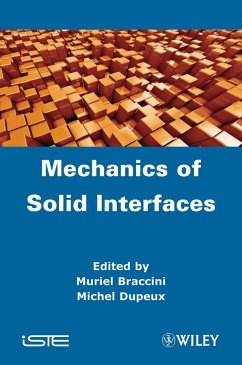- Gebundenes Buch
- Merkliste
- Auf die Merkliste
- Bewerten Bewerten
- Teilen
- Produkt teilen
- Produkterinnerung
- Produkterinnerung
The growing occurrence of heterogeneous materials such as composites or coated substrates in structural parts makes it necessary for designers and scientists to deal with the specific features of the mechanical behavior of solid interfaces. This book introduces basic concepts on mechanical problems related to the presence of solid/solid interfaces and their practical applications. The various topics discussed here are the mechanical characterization of interfaces, the initiation and growth of cracks along interfaces, the origin and control of interface adhesion, focusing in particular on thin…mehr
Andere Kunden interessierten sich auch für
![Full-Field Measurements and Identification in Solid Mechanics Full-Field Measurements and Identification in Solid Mechanics]() Full-Field Measurements and Identification in Solid Mechanics205,99 €
Full-Field Measurements and Identification in Solid Mechanics205,99 €![Nano and Cell Mechanics Nano and Cell Mechanics]() Horacio D. EspinosaNano and Cell Mechanics137,99 €
Horacio D. EspinosaNano and Cell Mechanics137,99 €![Mechanics of Unsaturated Geomaterials Mechanics of Unsaturated Geomaterials]() Lyesse LalouiMechanics of Unsaturated Geomaterials180,99 €
Lyesse LalouiMechanics of Unsaturated Geomaterials180,99 €![Mechanics of Materials Mechanics of Materials]() William F. RileyMechanics of Materials249,99 €
William F. RileyMechanics of Materials249,99 €![Solid Mechanics Using the Finte Element Method Solid Mechanics Using the Finte Element Method]() Alain BerliozSolid Mechanics Using the Finte Element Method158,99 €
Alain BerliozSolid Mechanics Using the Finte Element Method158,99 €![Performance-Based Gear Metrology Performance-Based Gear Metrology]() William D. MarkPerformance-Based Gear Metrology110,99 €
William D. MarkPerformance-Based Gear Metrology110,99 €![Fractional Order Motion Controls Fractional Order Motion Controls]() Ying LuoFractional Order Motion Controls105,99 €
Ying LuoFractional Order Motion Controls105,99 €-
-
-
The growing occurrence of heterogeneous materials such as composites or coated substrates in structural parts makes it necessary for designers and scientists to deal with the specific features of the mechanical behavior of solid interfaces.
This book introduces basic concepts on mechanical problems related to the presence of solid/solid interfaces and their practical applications. The various topics discussed here are the mechanical characterization of interfaces, the initiation and growth of cracks along interfaces, the origin and control of interface adhesion, focusing in particular on thin films on substrate systems. It is designed and structured to provide a solid background in the mechanics of heterogeneous materials to help students in materials science, as well as scientists and engineers.
This book introduces basic concepts on mechanical problems related to the presence of solid/solid interfaces and their practical applications. The various topics discussed here are the mechanical characterization of interfaces, the initiation and growth of cracks along interfaces, the origin and control of interface adhesion, focusing in particular on thin films on substrate systems. It is designed and structured to provide a solid background in the mechanics of heterogeneous materials to help students in materials science, as well as scientists and engineers.
Produktdetails
- Produktdetails
- ISTE .
- Verlag: Wiley & Sons
- 1. Auflage
- Seitenzahl: 320
- Erscheinungstermin: 13. Juli 2012
- Englisch
- Abmessung: 234mm x 157mm x 23mm
- Gewicht: 226g
- ISBN-13: 9781848213739
- ISBN-10: 1848213735
- Artikelnr.: 35953028
- Herstellerkennzeichnung
- Libri GmbH
- Europaallee 1
- 36244 Bad Hersfeld
- gpsr@libri.de
- ISTE .
- Verlag: Wiley & Sons
- 1. Auflage
- Seitenzahl: 320
- Erscheinungstermin: 13. Juli 2012
- Englisch
- Abmessung: 234mm x 157mm x 23mm
- Gewicht: 226g
- ISBN-13: 9781848213739
- ISBN-10: 1848213735
- Artikelnr.: 35953028
- Herstellerkennzeichnung
- Libri GmbH
- Europaallee 1
- 36244 Bad Hersfeld
- gpsr@libri.de
Muriel Braccini has been a CNRS research fellow since 2002. Her scientific interest rests in interface adhesion in heterogeneous materials. Her principal activities deal with the microstructure/properties relationship approach for non-organic materials. Michel Dupeux was appointed Assistant Lecturer in 1970, then became Lecturer at Grenoble Institut National Polytechnique, then finally Professor at Joseph Fourier University in Grenoble in 1989. His scientific interest rests in the micro-mechanical behavior of heterogeneous materials and interfaces, covering physical, chemical and structural aspects. He retired in 2009, but still keeps up an interest in his original scientific field and some scientific activity (textbook writing, textbook translation from English to French).
Foreword xi
Muriel BRACCINI and Michel DUPEUX
PART 1 FUNDAMENTALS 1
Chapter 1 Interfaces: the Physics, Chemistry and Mechanics of Heterogeneous
Continua 3
Michel DUPEUX and Muriel BRACCINI
1.1 Definition and terminology 3
1.2 Energy considerations 5
1.3 Elastic behavior of an interface 8
1.4 Experimental stress analysis techniques 18
1.5 Conclusion 24
1.6 Bibliography 25
Chapter 2 Structure and Defects of Crystalline Interfaces 27
Louisette PRIESTER
2.1 What is a crystalline interface? 27
2.2 Definitions and geometric tools to describe interfaces 29
2.3 Structure of interfaces: intrinsic dislocations and structural units 34
2.4 Linear interface defects: extrinsic dislocations 46
2.5 Interaction between dislocations and interfaces: relaxation of
interfacial stresses 47
2.6 Conclusion 59
2.7 Bibliography 60
PART 2 SINGULARITIES, NOTCHES AND INTERFACIAL CRACKS 65
Chapter 3 Singularities and Interfacial Cracks 67
Dominique LEGUILLON
3.1 Introduction 67
3.2 Singularities 69
3.3 Modal mixity 78
3.4 Brittle fracture mechanics 80
3.5 Nucleation of cracks 85
3.6 Deflection of a crack at an interface 91
3.7 Conclusion 96
3.8 Bibliography 97
Chapter 4 Interface Adherence 101
Muriel BRACCINI
4.1 Adhesion and adherence 101
4.2 Mode mixity 104
4.3 Measurement of adherence 107
4.4 Conclusion: choosing a test 126
4.5 Bibliography 127
PART 3 PRACTICAL APPLICATIONS 135
Chapter 5 Controlling Adherence 137
Thomas PARDOEN, Olivier DEZELLUS and Muriel BRACCINI
5.1 Introduction 137
5.2 Multiscale adherence modeling 140
5.3 Nature and control of interface bonds 145
5.4 Dissipative mechanisms 163
5.5.The effect of interface geometry 173
5.6 Conclusion 178
5.7 Bibliography 180
Chapter 6 Crack-interface Interaction 189
Eric MARTIN
6.1 Propagation of a crack near an interface 191
6.2 Criterion of crack deviation by an interface 194
6.3 Propagation of an interfacial crack 202
6.4 Branching criterion of a crack outside an interface 204
6.5 Conclusion 205
6.6 Bibliography 206
Chapter 7 Shock Mechanics and Interfaces 211
Michel ARRIGONI, Michel BOUSTIE, Cyril BOLIS, Sophie BARRADAS, Laurent
BERTHE and Michel JEANDIN
7.1 Introduction to shock wave mechanics 211
7.2 Damage under shock 227
7.3 Application to the shock adhesion test 230
7.4 Retrospective: recent advances made in shock adherence testing 240
7.5 Perspectives 243
7.6 Bibliography 243
PART 4 THIN FILMS 249
Chapter 8 Coating-Substrate Interfaces 251
Michel DUPEUX
8.1 Thin films on massive substrates: a typical case 251
8.2 State of stress in a thin film-substrate specimen 252
8.3 Residual strains in thin films 262
8.4 Determination of stresses in thin films 266
8.5 Conclusions 269
8.6 Bibliography 270
Chapter 9 Damage in Thin Films on Substrates 273
Michel DUPEUX, Muriel BRACCINI and Guillaume PARRY
9.1 Overview 273
9.2 Layers in tension 277
9.3 Films in compression 284
9.4 Conclusion 291
9.5 Bibliography 292
List of Authors 295
Index 297
Muriel BRACCINI and Michel DUPEUX
PART 1 FUNDAMENTALS 1
Chapter 1 Interfaces: the Physics, Chemistry and Mechanics of Heterogeneous
Continua 3
Michel DUPEUX and Muriel BRACCINI
1.1 Definition and terminology 3
1.2 Energy considerations 5
1.3 Elastic behavior of an interface 8
1.4 Experimental stress analysis techniques 18
1.5 Conclusion 24
1.6 Bibliography 25
Chapter 2 Structure and Defects of Crystalline Interfaces 27
Louisette PRIESTER
2.1 What is a crystalline interface? 27
2.2 Definitions and geometric tools to describe interfaces 29
2.3 Structure of interfaces: intrinsic dislocations and structural units 34
2.4 Linear interface defects: extrinsic dislocations 46
2.5 Interaction between dislocations and interfaces: relaxation of
interfacial stresses 47
2.6 Conclusion 59
2.7 Bibliography 60
PART 2 SINGULARITIES, NOTCHES AND INTERFACIAL CRACKS 65
Chapter 3 Singularities and Interfacial Cracks 67
Dominique LEGUILLON
3.1 Introduction 67
3.2 Singularities 69
3.3 Modal mixity 78
3.4 Brittle fracture mechanics 80
3.5 Nucleation of cracks 85
3.6 Deflection of a crack at an interface 91
3.7 Conclusion 96
3.8 Bibliography 97
Chapter 4 Interface Adherence 101
Muriel BRACCINI
4.1 Adhesion and adherence 101
4.2 Mode mixity 104
4.3 Measurement of adherence 107
4.4 Conclusion: choosing a test 126
4.5 Bibliography 127
PART 3 PRACTICAL APPLICATIONS 135
Chapter 5 Controlling Adherence 137
Thomas PARDOEN, Olivier DEZELLUS and Muriel BRACCINI
5.1 Introduction 137
5.2 Multiscale adherence modeling 140
5.3 Nature and control of interface bonds 145
5.4 Dissipative mechanisms 163
5.5.The effect of interface geometry 173
5.6 Conclusion 178
5.7 Bibliography 180
Chapter 6 Crack-interface Interaction 189
Eric MARTIN
6.1 Propagation of a crack near an interface 191
6.2 Criterion of crack deviation by an interface 194
6.3 Propagation of an interfacial crack 202
6.4 Branching criterion of a crack outside an interface 204
6.5 Conclusion 205
6.6 Bibliography 206
Chapter 7 Shock Mechanics and Interfaces 211
Michel ARRIGONI, Michel BOUSTIE, Cyril BOLIS, Sophie BARRADAS, Laurent
BERTHE and Michel JEANDIN
7.1 Introduction to shock wave mechanics 211
7.2 Damage under shock 227
7.3 Application to the shock adhesion test 230
7.4 Retrospective: recent advances made in shock adherence testing 240
7.5 Perspectives 243
7.6 Bibliography 243
PART 4 THIN FILMS 249
Chapter 8 Coating-Substrate Interfaces 251
Michel DUPEUX
8.1 Thin films on massive substrates: a typical case 251
8.2 State of stress in a thin film-substrate specimen 252
8.3 Residual strains in thin films 262
8.4 Determination of stresses in thin films 266
8.5 Conclusions 269
8.6 Bibliography 270
Chapter 9 Damage in Thin Films on Substrates 273
Michel DUPEUX, Muriel BRACCINI and Guillaume PARRY
9.1 Overview 273
9.2 Layers in tension 277
9.3 Films in compression 284
9.4 Conclusion 291
9.5 Bibliography 292
List of Authors 295
Index 297
Foreword xi
Muriel BRACCINI and Michel DUPEUX
PART 1 FUNDAMENTALS 1
Chapter 1 Interfaces: the Physics, Chemistry and Mechanics of Heterogeneous
Continua 3
Michel DUPEUX and Muriel BRACCINI
1.1 Definition and terminology 3
1.2 Energy considerations 5
1.3 Elastic behavior of an interface 8
1.4 Experimental stress analysis techniques 18
1.5 Conclusion 24
1.6 Bibliography 25
Chapter 2 Structure and Defects of Crystalline Interfaces 27
Louisette PRIESTER
2.1 What is a crystalline interface? 27
2.2 Definitions and geometric tools to describe interfaces 29
2.3 Structure of interfaces: intrinsic dislocations and structural units 34
2.4 Linear interface defects: extrinsic dislocations 46
2.5 Interaction between dislocations and interfaces: relaxation of
interfacial stresses 47
2.6 Conclusion 59
2.7 Bibliography 60
PART 2 SINGULARITIES, NOTCHES AND INTERFACIAL CRACKS 65
Chapter 3 Singularities and Interfacial Cracks 67
Dominique LEGUILLON
3.1 Introduction 67
3.2 Singularities 69
3.3 Modal mixity 78
3.4 Brittle fracture mechanics 80
3.5 Nucleation of cracks 85
3.6 Deflection of a crack at an interface 91
3.7 Conclusion 96
3.8 Bibliography 97
Chapter 4 Interface Adherence 101
Muriel BRACCINI
4.1 Adhesion and adherence 101
4.2 Mode mixity 104
4.3 Measurement of adherence 107
4.4 Conclusion: choosing a test 126
4.5 Bibliography 127
PART 3 PRACTICAL APPLICATIONS 135
Chapter 5 Controlling Adherence 137
Thomas PARDOEN, Olivier DEZELLUS and Muriel BRACCINI
5.1 Introduction 137
5.2 Multiscale adherence modeling 140
5.3 Nature and control of interface bonds 145
5.4 Dissipative mechanisms 163
5.5.The effect of interface geometry 173
5.6 Conclusion 178
5.7 Bibliography 180
Chapter 6 Crack-interface Interaction 189
Eric MARTIN
6.1 Propagation of a crack near an interface 191
6.2 Criterion of crack deviation by an interface 194
6.3 Propagation of an interfacial crack 202
6.4 Branching criterion of a crack outside an interface 204
6.5 Conclusion 205
6.6 Bibliography 206
Chapter 7 Shock Mechanics and Interfaces 211
Michel ARRIGONI, Michel BOUSTIE, Cyril BOLIS, Sophie BARRADAS, Laurent
BERTHE and Michel JEANDIN
7.1 Introduction to shock wave mechanics 211
7.2 Damage under shock 227
7.3 Application to the shock adhesion test 230
7.4 Retrospective: recent advances made in shock adherence testing 240
7.5 Perspectives 243
7.6 Bibliography 243
PART 4 THIN FILMS 249
Chapter 8 Coating-Substrate Interfaces 251
Michel DUPEUX
8.1 Thin films on massive substrates: a typical case 251
8.2 State of stress in a thin film-substrate specimen 252
8.3 Residual strains in thin films 262
8.4 Determination of stresses in thin films 266
8.5 Conclusions 269
8.6 Bibliography 270
Chapter 9 Damage in Thin Films on Substrates 273
Michel DUPEUX, Muriel BRACCINI and Guillaume PARRY
9.1 Overview 273
9.2 Layers in tension 277
9.3 Films in compression 284
9.4 Conclusion 291
9.5 Bibliography 292
List of Authors 295
Index 297
Muriel BRACCINI and Michel DUPEUX
PART 1 FUNDAMENTALS 1
Chapter 1 Interfaces: the Physics, Chemistry and Mechanics of Heterogeneous
Continua 3
Michel DUPEUX and Muriel BRACCINI
1.1 Definition and terminology 3
1.2 Energy considerations 5
1.3 Elastic behavior of an interface 8
1.4 Experimental stress analysis techniques 18
1.5 Conclusion 24
1.6 Bibliography 25
Chapter 2 Structure and Defects of Crystalline Interfaces 27
Louisette PRIESTER
2.1 What is a crystalline interface? 27
2.2 Definitions and geometric tools to describe interfaces 29
2.3 Structure of interfaces: intrinsic dislocations and structural units 34
2.4 Linear interface defects: extrinsic dislocations 46
2.5 Interaction between dislocations and interfaces: relaxation of
interfacial stresses 47
2.6 Conclusion 59
2.7 Bibliography 60
PART 2 SINGULARITIES, NOTCHES AND INTERFACIAL CRACKS 65
Chapter 3 Singularities and Interfacial Cracks 67
Dominique LEGUILLON
3.1 Introduction 67
3.2 Singularities 69
3.3 Modal mixity 78
3.4 Brittle fracture mechanics 80
3.5 Nucleation of cracks 85
3.6 Deflection of a crack at an interface 91
3.7 Conclusion 96
3.8 Bibliography 97
Chapter 4 Interface Adherence 101
Muriel BRACCINI
4.1 Adhesion and adherence 101
4.2 Mode mixity 104
4.3 Measurement of adherence 107
4.4 Conclusion: choosing a test 126
4.5 Bibliography 127
PART 3 PRACTICAL APPLICATIONS 135
Chapter 5 Controlling Adherence 137
Thomas PARDOEN, Olivier DEZELLUS and Muriel BRACCINI
5.1 Introduction 137
5.2 Multiscale adherence modeling 140
5.3 Nature and control of interface bonds 145
5.4 Dissipative mechanisms 163
5.5.The effect of interface geometry 173
5.6 Conclusion 178
5.7 Bibliography 180
Chapter 6 Crack-interface Interaction 189
Eric MARTIN
6.1 Propagation of a crack near an interface 191
6.2 Criterion of crack deviation by an interface 194
6.3 Propagation of an interfacial crack 202
6.4 Branching criterion of a crack outside an interface 204
6.5 Conclusion 205
6.6 Bibliography 206
Chapter 7 Shock Mechanics and Interfaces 211
Michel ARRIGONI, Michel BOUSTIE, Cyril BOLIS, Sophie BARRADAS, Laurent
BERTHE and Michel JEANDIN
7.1 Introduction to shock wave mechanics 211
7.2 Damage under shock 227
7.3 Application to the shock adhesion test 230
7.4 Retrospective: recent advances made in shock adherence testing 240
7.5 Perspectives 243
7.6 Bibliography 243
PART 4 THIN FILMS 249
Chapter 8 Coating-Substrate Interfaces 251
Michel DUPEUX
8.1 Thin films on massive substrates: a typical case 251
8.2 State of stress in a thin film-substrate specimen 252
8.3 Residual strains in thin films 262
8.4 Determination of stresses in thin films 266
8.5 Conclusions 269
8.6 Bibliography 270
Chapter 9 Damage in Thin Films on Substrates 273
Michel DUPEUX, Muriel BRACCINI and Guillaume PARRY
9.1 Overview 273
9.2 Layers in tension 277
9.3 Films in compression 284
9.4 Conclusion 291
9.5 Bibliography 292
List of Authors 295
Index 297








